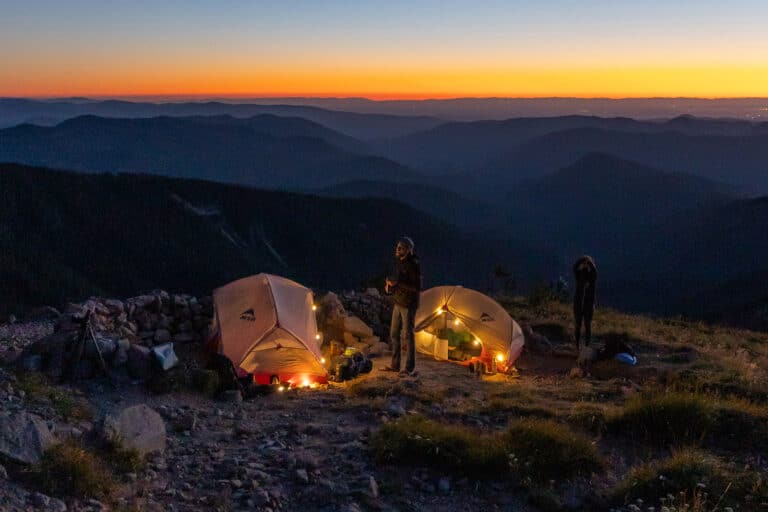If hunters and anglers pay for licenses, should other outdoor enthusiasts pony up, too?
It’s a Saturday in summer and, as usual, Pisgah National Forest is slammed.
Parked cars line the stretch of U.S. 276 that runs through the forest. Campgrounds and picnic areas are packed. Dumpsters overflow. Mountain bikers and hikers navigate perilous paths to trailheads through bumper-to-bumper traffic.
As the co-owner of The Hub, an outfitter, bike shop and tavern at the forest’s entrance near Brevard, N.C., Jordan Salman is in the perfect spot to capitalize on these crowds—and to see the desperate need for more public lands funding to accommodate them.
She would even favor a tax that she hadn’t heard of until recently, one that would be levied directly on the goods she sells. Commonly known as the backpack tax, it would be applied to outdoor equipment such as hiking boots, packs, and tents.
“If it went up across the board to companies like Keen and Merrell and Osprey, and if it was built into their pricing, then absolutely, we’d be all for it,” she said.
Such a proposal—representing, as it does, the politically toxic notion of a new tax—has less support than other means of raising money to enhance outdoor recreation and protect natural lands, including charging user fees and tapping into existing revenue streams.
But proponents say a backpack tax would be a fair, efficient solution, and one that would ultimately address a longstanding complaint of hikers and mountain bikers: when it comes to environmental policy, their voices are drowned out by far smaller numbers of hunters and anglers who have long paid steep excise taxes on equipment.

“That’s why the backpack tax makes so much sense,” said Andy Stahl, executive director of the non-profit Forest Service Employees for Environmental Ethics. “Yes, it’s a sales tax, but it’s a sales tax on a luxury item that benefits folks who want to make sure they have a place to use that luxury item.”
Hunters—in fact, all gun owners—have paid an 11 percent excise tax on ammunition and rifles since 1937, when the federal government passed the Pittman-Robertson Act, which also levies a 10 percent fee on handguns. Anglers have paid 10 percent on tackle since the passage of the Dingell-Johnson Act in 1950.
Along with licenses, these taxes account for 80 percent of the funding for state wildlife agencies across the country.
In the 1990s, groups including the Association of Fish & Wildlife Agencies saw the backpack tax as the hiker’s version of such equipment taxes. As an excise tax, it would have been levied at the point of manufacture and applied to a wide variety of outdoor equipment, from packs to kayaks to climbing harnesses.
It faced stiff opposition from outdoor gear makers and retailers. And federal lawmakers who supported the measure relayed the message that it faced dim prospects in an increasingly tax-averse U.S. Congress, said Mark Humpert, the Association’s director of conservation initiatives.
So in 1999, when an ambitious bill was introduced to fund recreation and preservation — the Conservation and Reinvestment Act (CARA) — it relied on different sources of revenue, including offshore oil and gas drilling leases. One of the act’s main provisions was a guarantee that $900 million annually from these lease payments would be funneled into the Land and Water Conservation Fund.
“Unless our nation makes a change in the way we fund conservation, the number of species on the brink of extinction will grow significantly.”
After the bill stalled in the Senate the following year, it was replaced by vague pledges to fund conservation and recreation—pledges that have mostly not been fulfilled. Since 2010 appropriation for the Land and Water Conservation Fund has reached, at most, half of the allowed $900 million and, many years, far less. In 2016, for example, the allocation for the fund was a mere $306 million.
And in the past decade, overall investment in public lands and water has dropped from 2 percent of the federal government’s discretionary spending to less than 1 percent, said Alex Boian, vice president of government affairs for the Outdoor Industry Association, which represents gear makers and retailers.
The results can be seen not only in the overwhelmed state of natural lands, but in the bottom lines of the agencies that manage them. The Forest Service, for example, faces a backlog of $300 million just for trail maintenance, while the National Park Service’s total infrastructure backlog recently reached a whopping $11.6 billion.
“They really are starving some of these agencies,” Boian said.
It’s a trend that could have dire long-term consequences on both the economy and the environment.
A recent study by the Outdoor Industry Association produced compelling evidence for the benefits of investing in outdoor recreation. Spending in this sector—including travel, services and big-ticket items such as recreational vehicles —totals $887 billion annually and generates $124.5 billion in federal, state and local taxes, the study found.
That includes import taxes on outdoor gear that are far higher than on most other consumer goods, tariffs that average 14 percent and top out at “37.5 percent for a high-end Gore-Tex trail runner,” Boian said.
The National Wildlife Federation has an even stronger argument for increased funding for natural lands—potential mass extinction.
State wildlife agencies have identified about 12,000 species in need of proactive protection, according to its website, and have charted alarming population declines of a vast variety of wild creatures, including mammals, birds, reptiles, butterflies, bees, and bats.
“Unless our nation makes a change in the way we fund conservation, the number of species on the brink of extinction will grow significantly,” the site states.
Instead of backing an excise tax on gear, however, these groups—as well as hiking and mountain biking organizations—support bolstering the Land and Water Conservation Fund or creating a new fund that would be fed by similar sources.
The OIA, which was formed partly to oppose taxes on outdoor equipment, maintains this position. And three of the biggest players in the industry—North Face, REI, and Patagonia—failed to respond to questions about a possible tax and touted their voluntary contributions to conservation.
Instead of agreeing to a tax, Boian said, outdoor enthusiasts should pressure elected officials to earmark the full $900 million into the existing fund and to extend its lifespan.
“We argue there is more than enough revenue to pay for the National Parks’ infrastructure backlog,” he said. “The government has the money. Conservation should be a shared national priority, just like education, just like national defense.”
Supporting the Land and Water Conservation Fund is also the priority of the Southern Off-Road Bicycling Association (SORBA) and the Appalachian Trail Conservancy (ATC).
“Building more support for the Land and Water Conservation Fund is our major focus,” said Laura Belleville, ATC’s vice president of conservation and trail programs.
The Outdoor Industry Association and National Wildlife Federation also support the recommendation of a Blue Ribbon Panel of industry and environmental groups convened in 2016 by the Association of Fish & Wildlife Agencies.

The panel considered a backpack tax, Humpert said, but instead opted for a plan to divert $1.3 billion in funds from a larger pool than the one that supports the Land and Water Conservation Fund. It would include mining leases on federal land and drilling leases both on federal land and offshore that generate about $13 billion annually.
The proposal is part of the Recovering America’s Wildlife Act, a bill that already has been introduced in the U.S. House of Representatives and is due to be introduced into the U.S. Senate by a bipartisan group of sponsors, Boian said.
This fund would pump large sums into state wildlife agencies—about $29 million in North Carolina, $24 million in Virginia and $30 million in Georgia—and allow them to broaden their focus beyond fish and game.
“Instead of just paying for deer and ducks and game species, it would include song birds and butterflies and reptiles, all of which wildlife agencies have to manage for but don’t have any money to do it with,” said Whit Fosburgh, president and CEO of the Theodore Roosevelt Conservation Partnership.
Unfortunately, Stahl said, the funding is not guaranteed, which means lawmakers can, and probably will, shortchange the new fund just as they have the old one.
“It just puts us back in the same boat,” he said.
It also creates a “perverse incentive” by relying on activities that destroy the environment in a measure that purports to conserve it, Stahl said. “It’s an attempt to green veneer on drilling and mining … the oil companies are basically saying, ‘Let us drill off your beautiful coastline and we’ll take a portion of this money and let you build a little park.’ But in the meantime you get a Deepwater Horizon oil spill.”
And unlike equipment taxes or user fees —which are more cumbersome and expensive to collect—this funding structure fails to sends a message to land managers that hikers and other groups are willing to invest in the forest.
“The growth we’ve seen has been exponential, just out of control. It really feels unsustainable.”
The same could be said of many of the conservation funding plans at the state level.
The website of Great Outdoors Colorado (GOCO) boasts that since 1992 it has spent more than $1.1 billion on, among other projects, building trails and community parks and acquiring natural lands.
That’s all great, Stahl said, except that it relies on lottery funding, “the most regressive tax known to mankind … It’s paid for by poor people who are addicted to gambling and who can’t even afford to pay for the gas to get to state parks.”
In June, California voters approved Proposition 68, a $4.1 billion bond issue to fund outdoor recreation and land and water conservation projects, but did so without creating a new funding source to pay off the bonds.
Closer to home, Georgia lawmakers passed the Georgia Outdoor Stewardship Act. If voters approve the measure in November, it would generate about $21 million annually for conservation and recreation by diverting 40 percent of the existing sales tax on a wide array of sporting goods.
“They are just cleaving off a portion of the money the state is already collecting,” Fosburgh said. “I don’t have any strong feelings about any particular proposal, but I think it would be a good thing for users to generate more money.”
The reason the Stewardship Act did not take that approach is the same reason that no state is currently considering a true backpack tax.
“A new tax would not be politically palatable,” said Thomas Farmer, senior policy advisor for the Nature Conservancy in Georgia.
Or maybe it would be.
Some users interviewed object to the tax, citing long-standing criticism that it disproportionately discourages young and poor users from enjoying the outdoors, and that it undermines the democratic ideal of parks and forests.
“Some things should just be part of being an American, like swimming in the ocean or going into the forest,” said Michele Barg, 71, a retired immunologist who is an avid hiker and part-time employee at The Hub. A backpack tax “would be like imposing a swimsuit tax on people who want to use the ocean.”
But representatives of both the ATC and SORBA said they may be receptive to the idea of a tax on equipment their members use, depending on what form it took.
“We generally support pay to play,” said Tom Sauret, SORBA’s executive director. “We’re not set against discussing any kind of fees, though we would have to see the legislation before we could take a position.”
His group has stood behind a Forest Service plan to charge user fees for mountain bikers and horseback riders in the Pisgah Ranger District. So has Barg’s boss, Salman, who also advocates parking fees at popular trailheads. She would favor a backpack tax for the same reason: to give hikers equal say in land management, mostly because she sees the strain users place on the forest.
In the 10 years she and her husband, Sam, have owned the shop, “the growth we’ve seen has been exponential, just out of control. It really feels unsustainable.”
And though anglers and hunters are viewed as politically conservative and, presumably, anti-tax, most of them have no objection to paying the Dingell-Johnson or Pittman-Robertson taxes, said Derrell Brushaber, 72, a fishing guide who regularly works in Pisgah. “I’m all for it, believe it or not, because I can see the good it does.”
He would also support a tax targeting other users, he said. “The amount of use Pisgah gets from mountain bikers and hikers, that’s a lot of nice good tax income for sure.”








